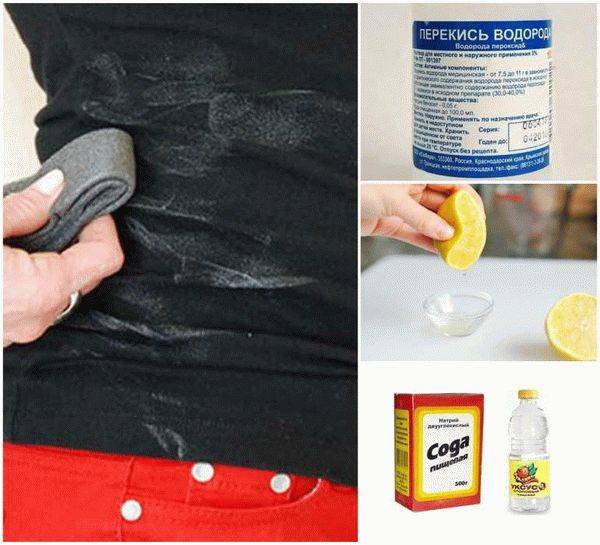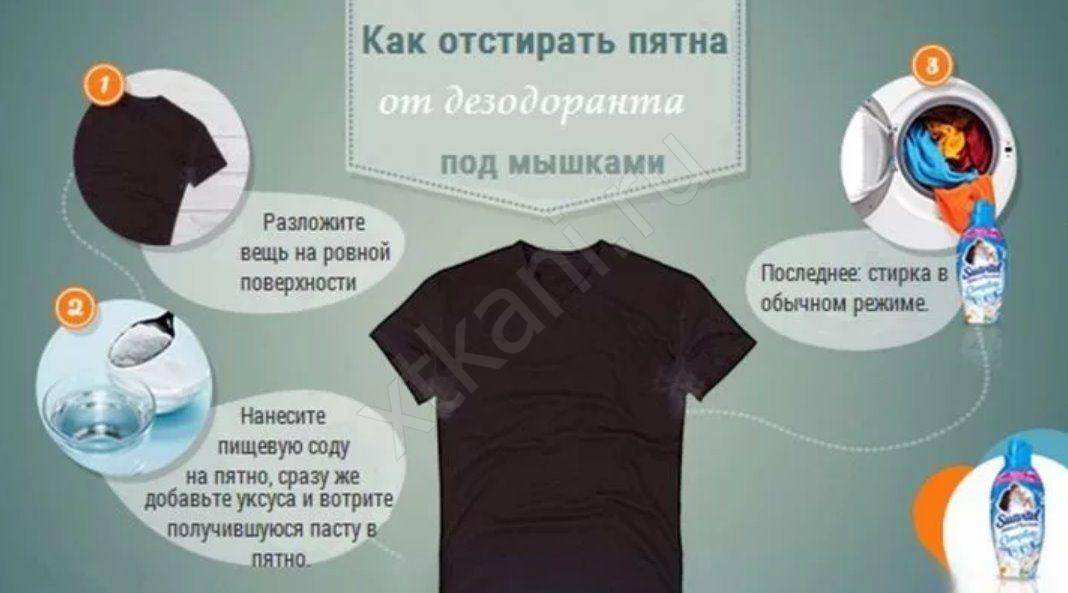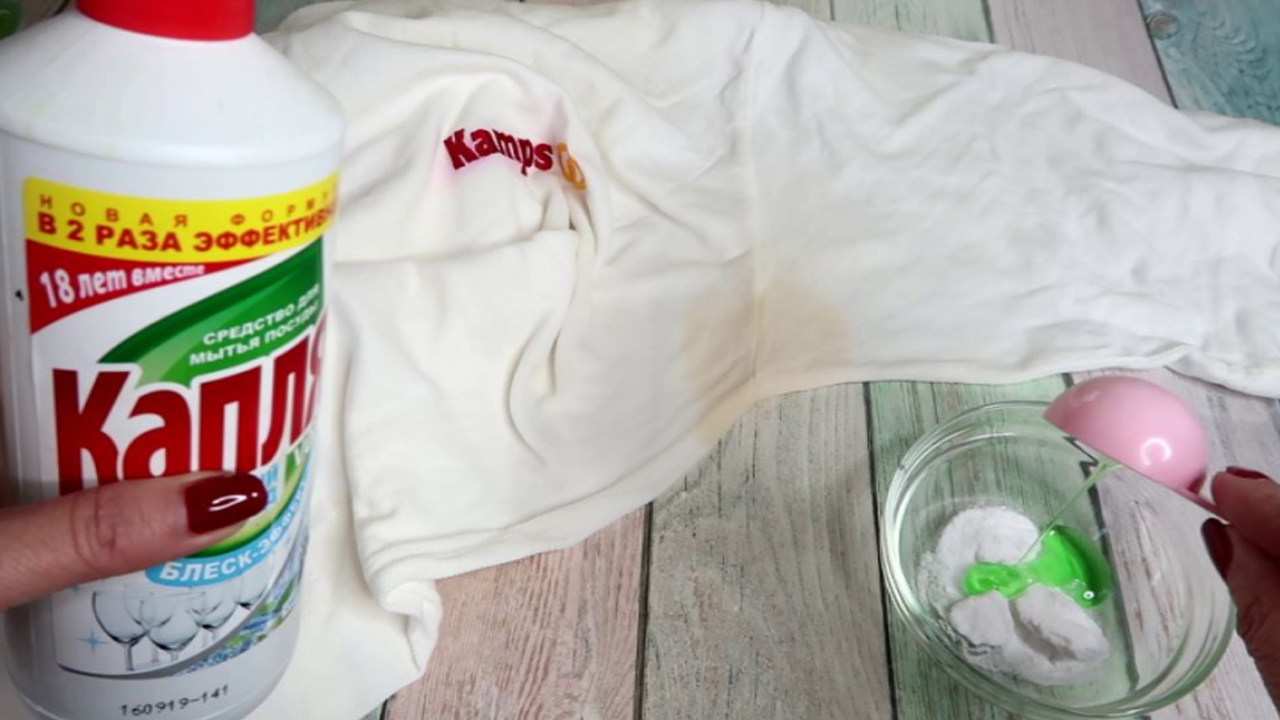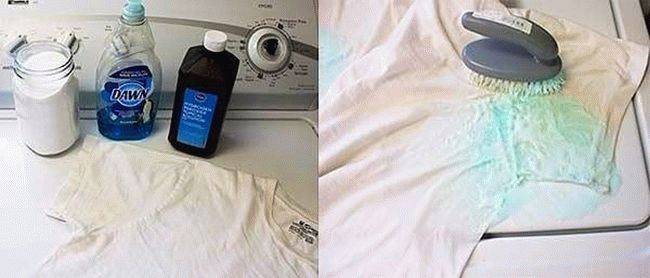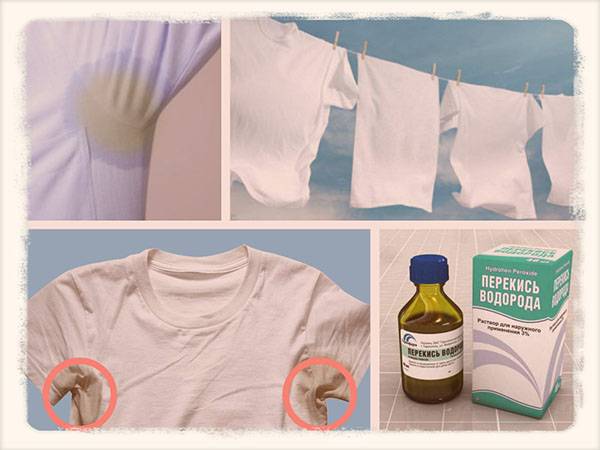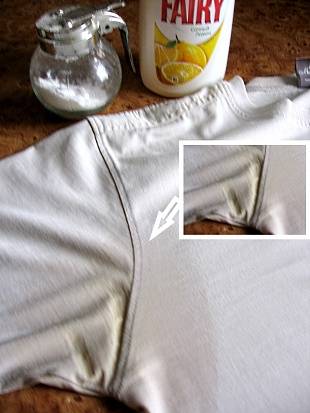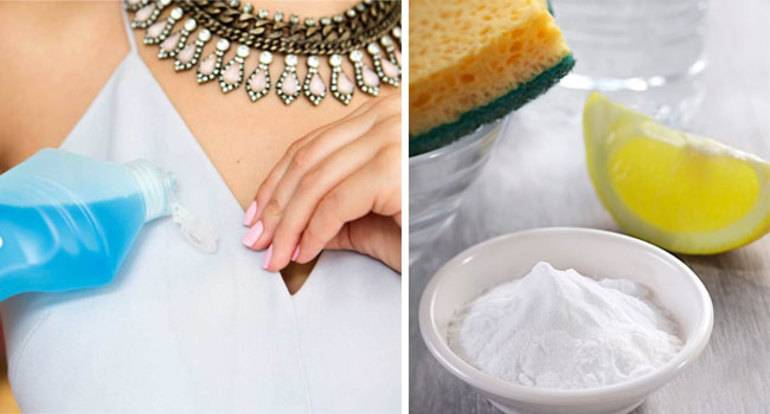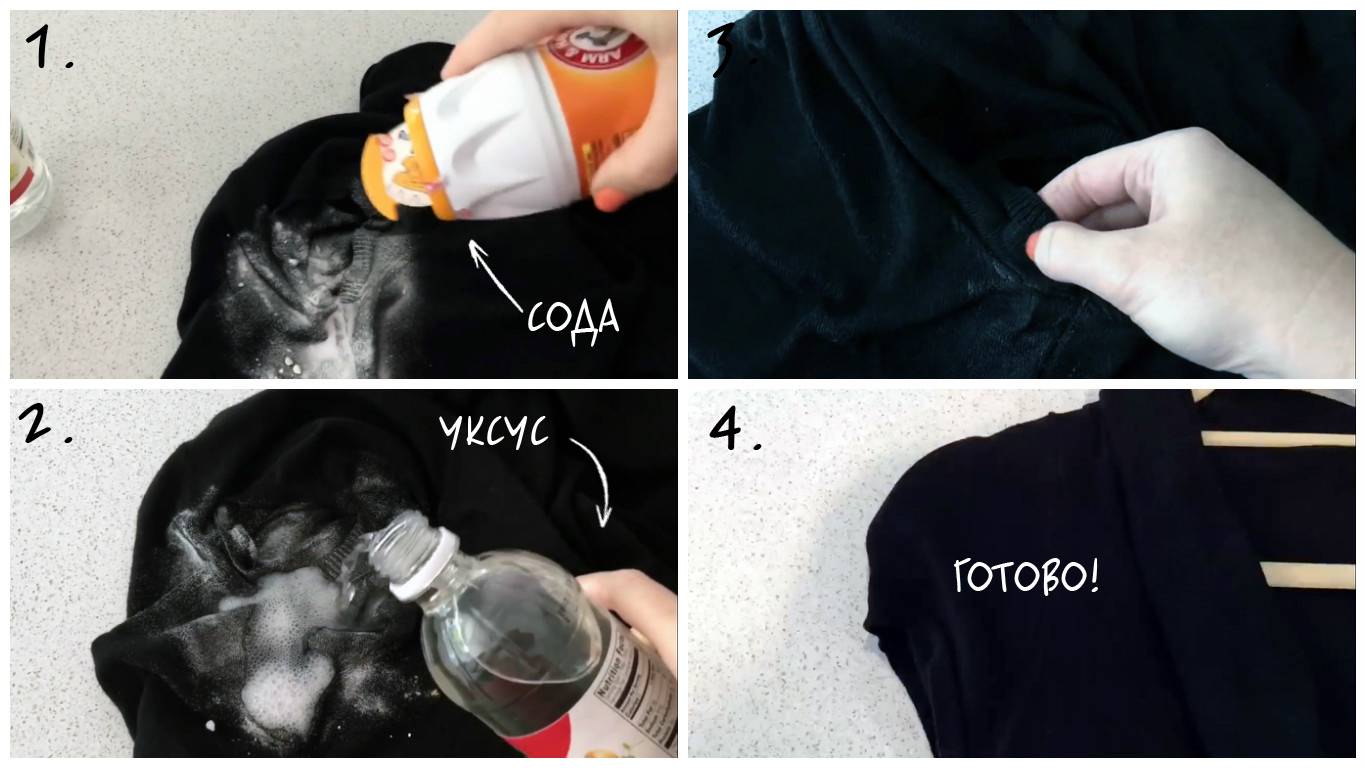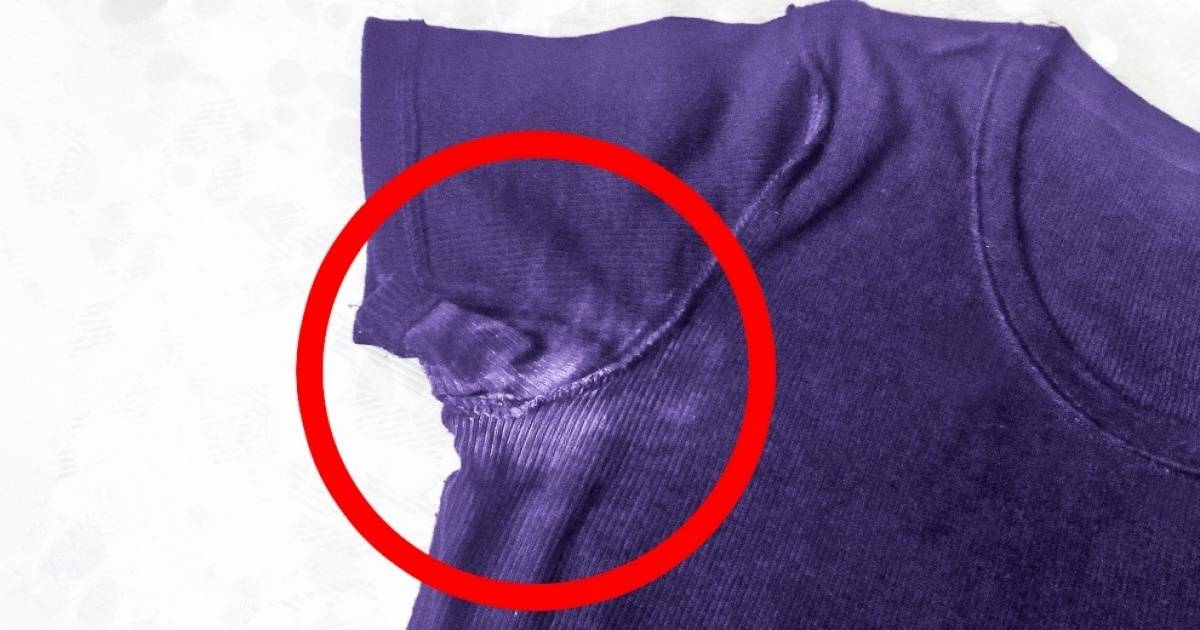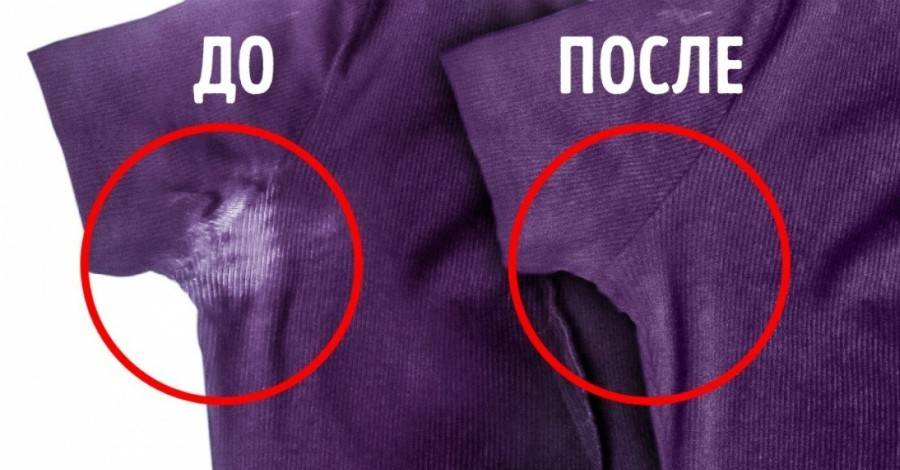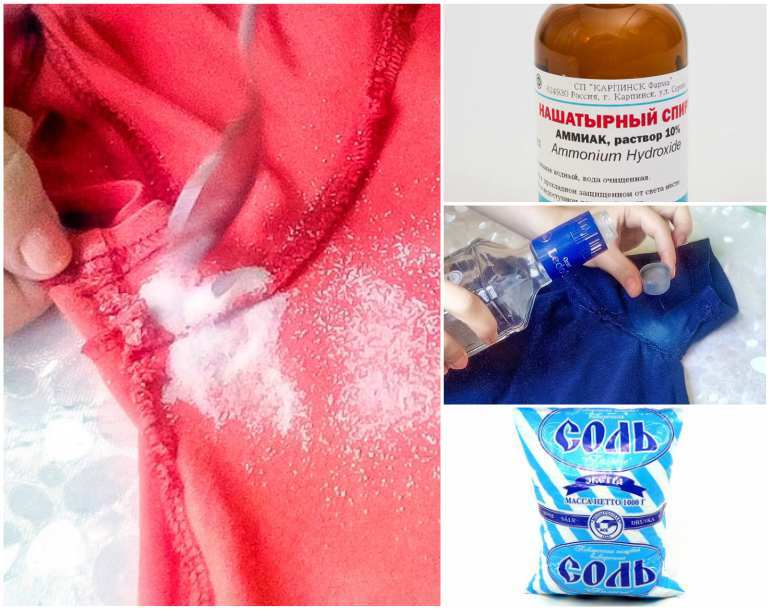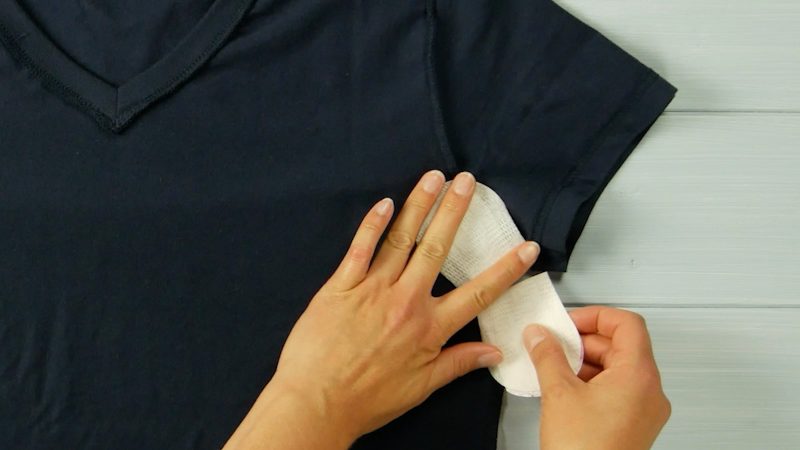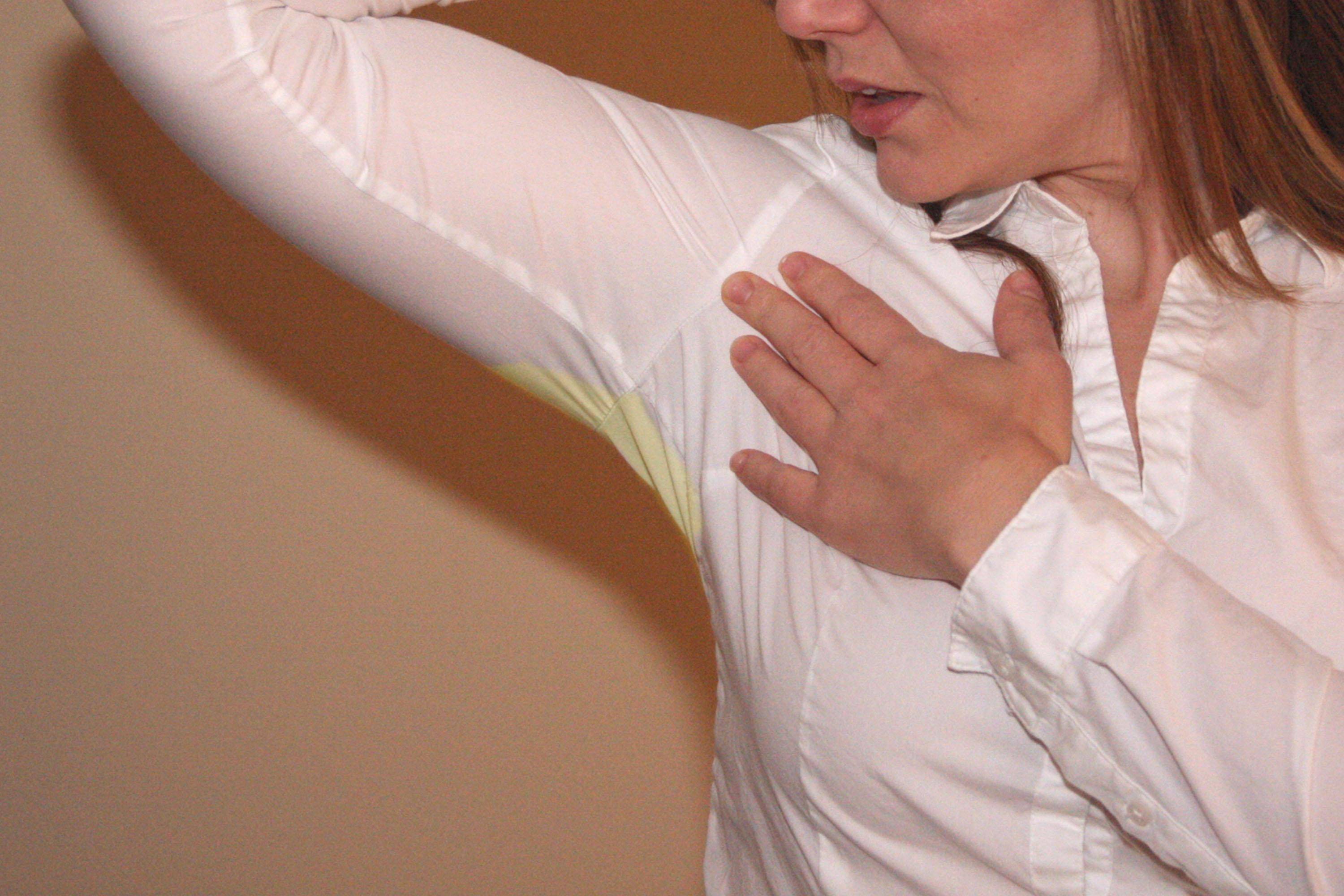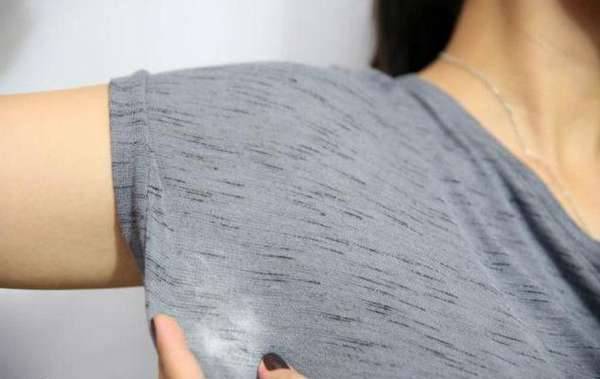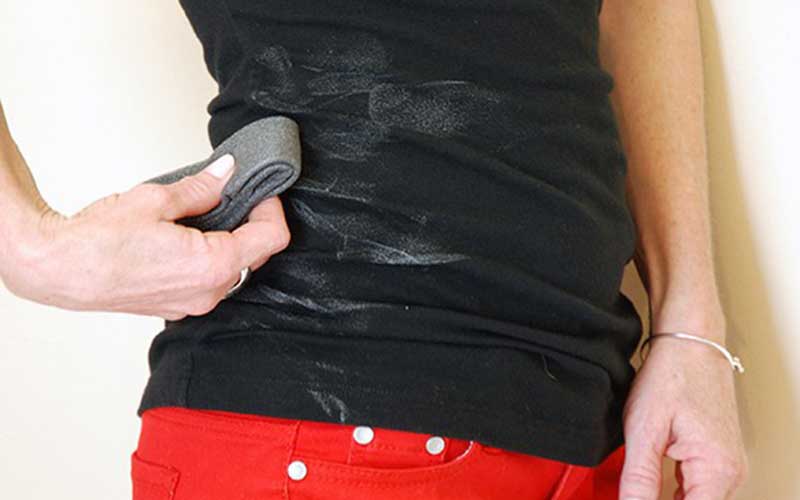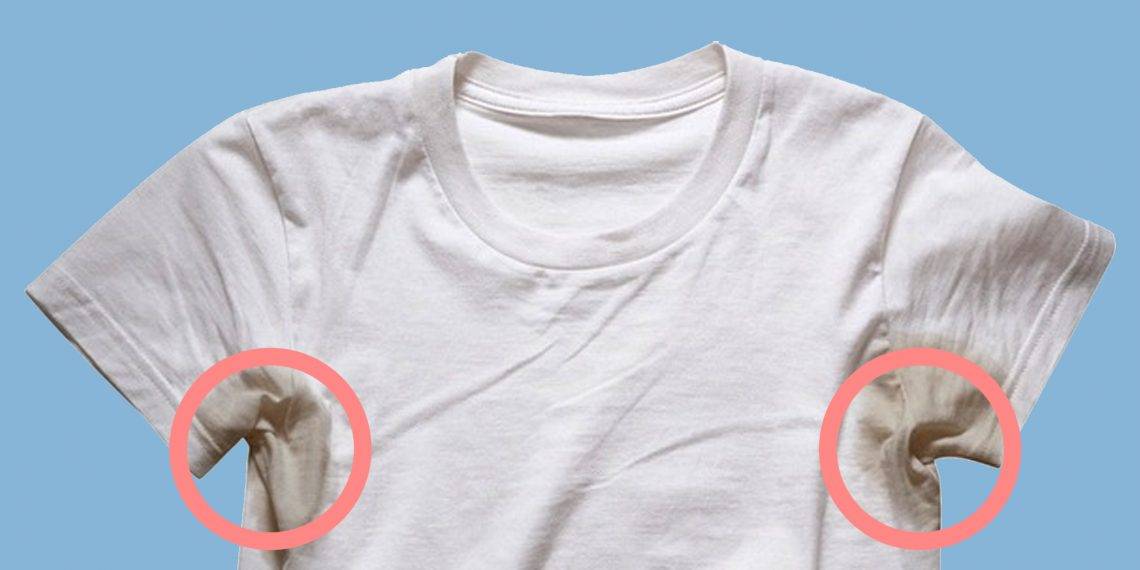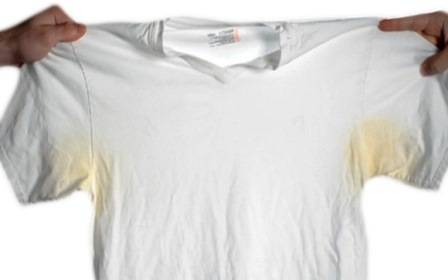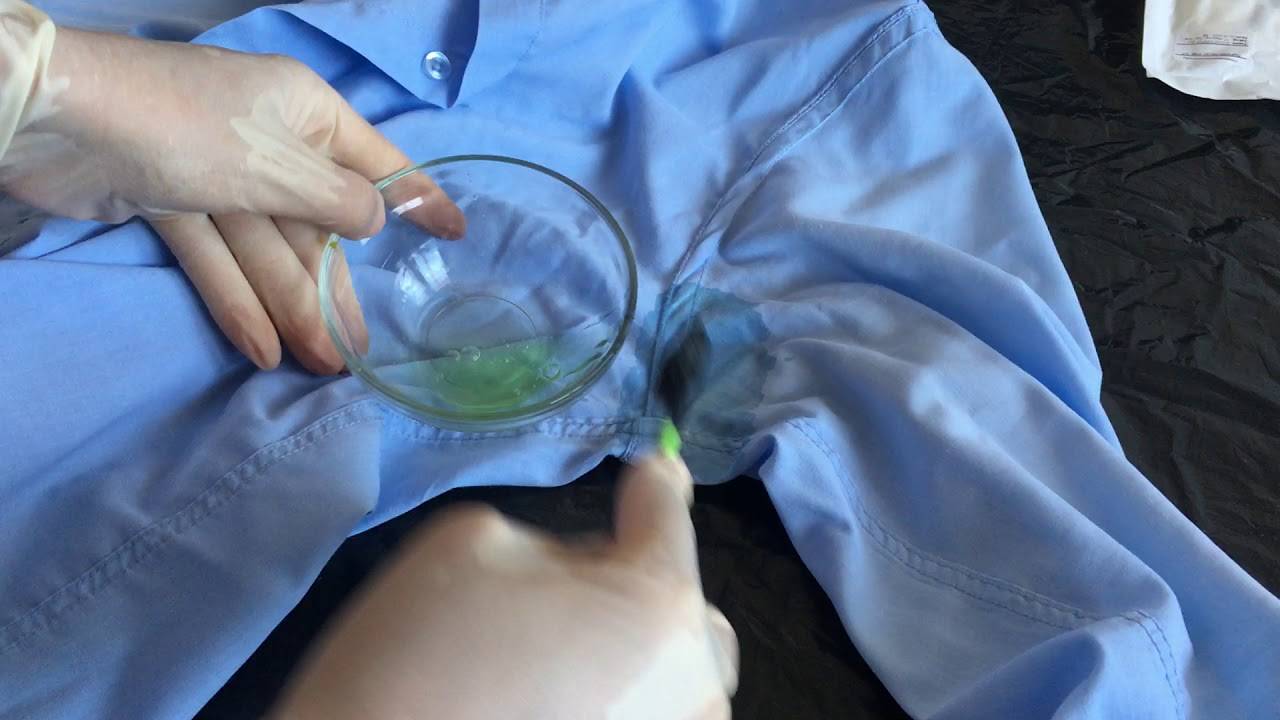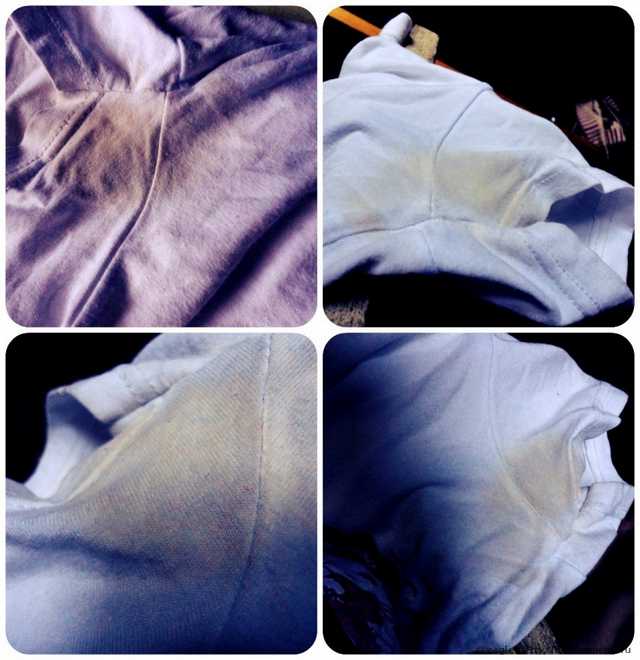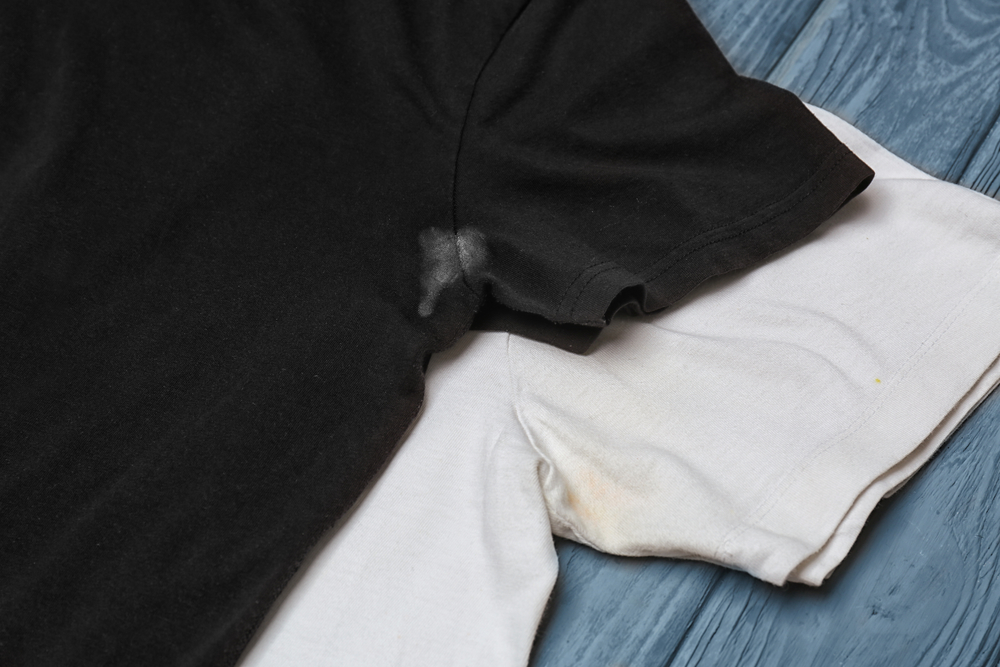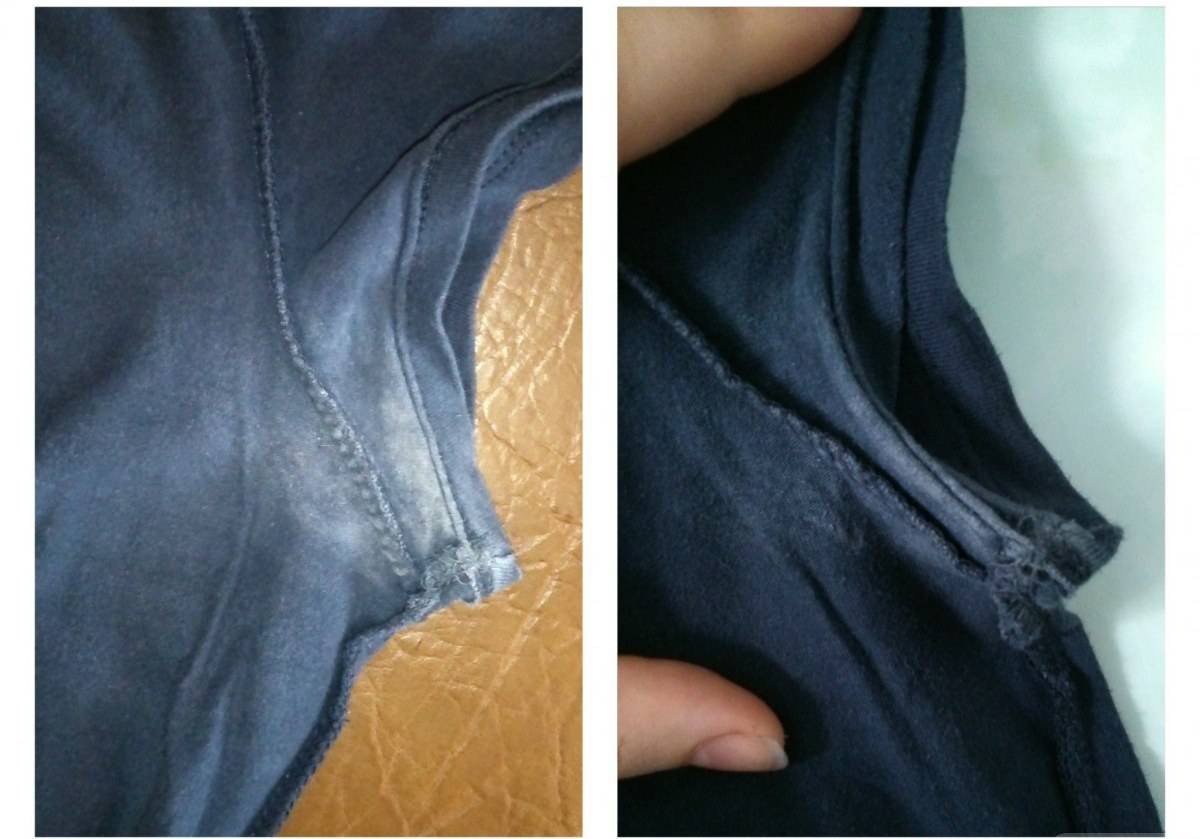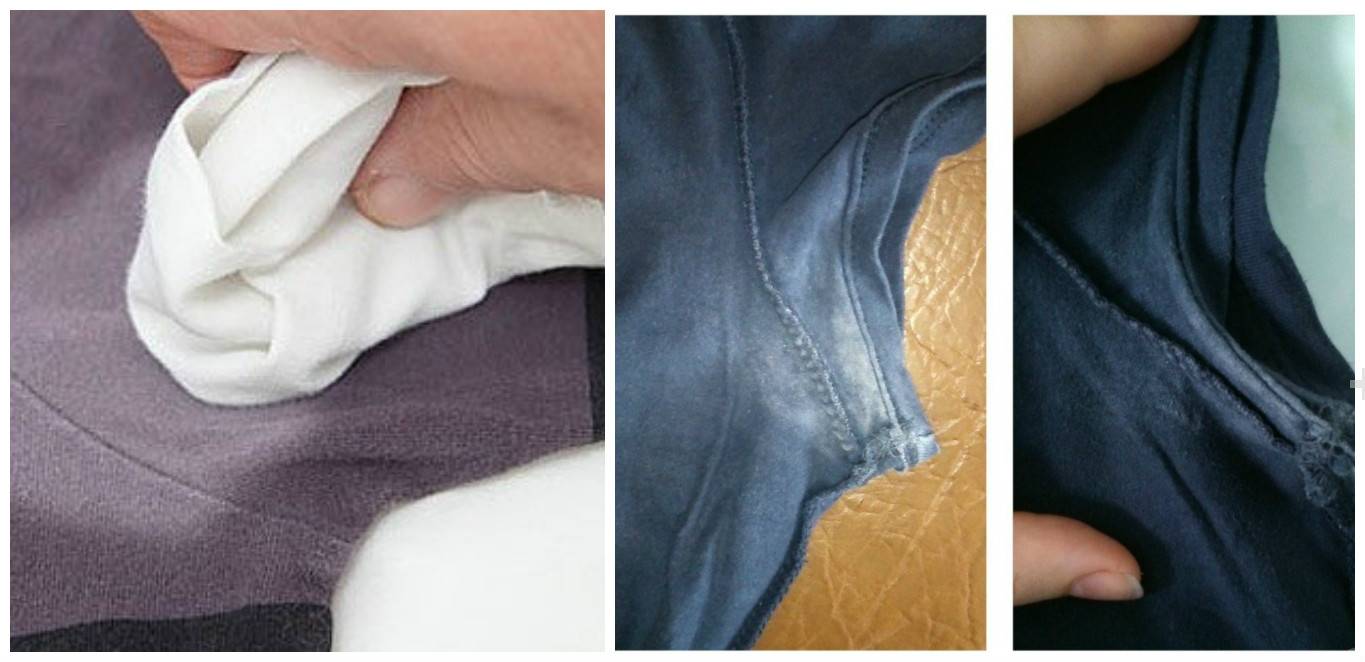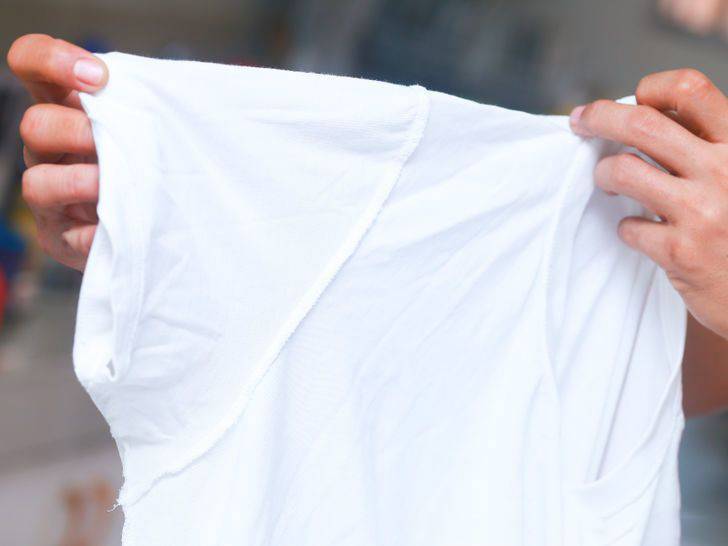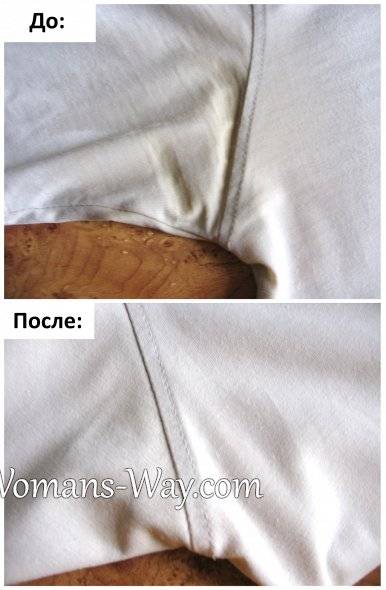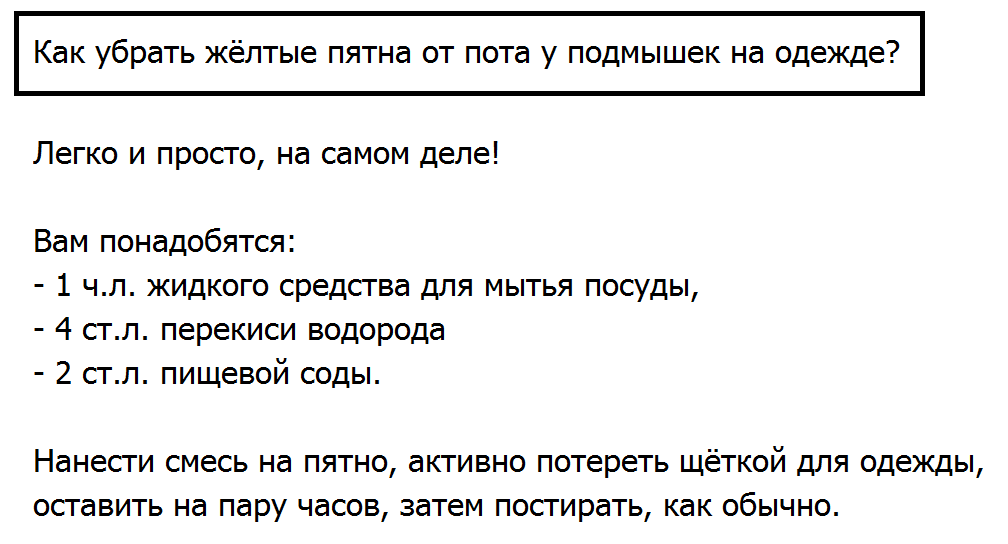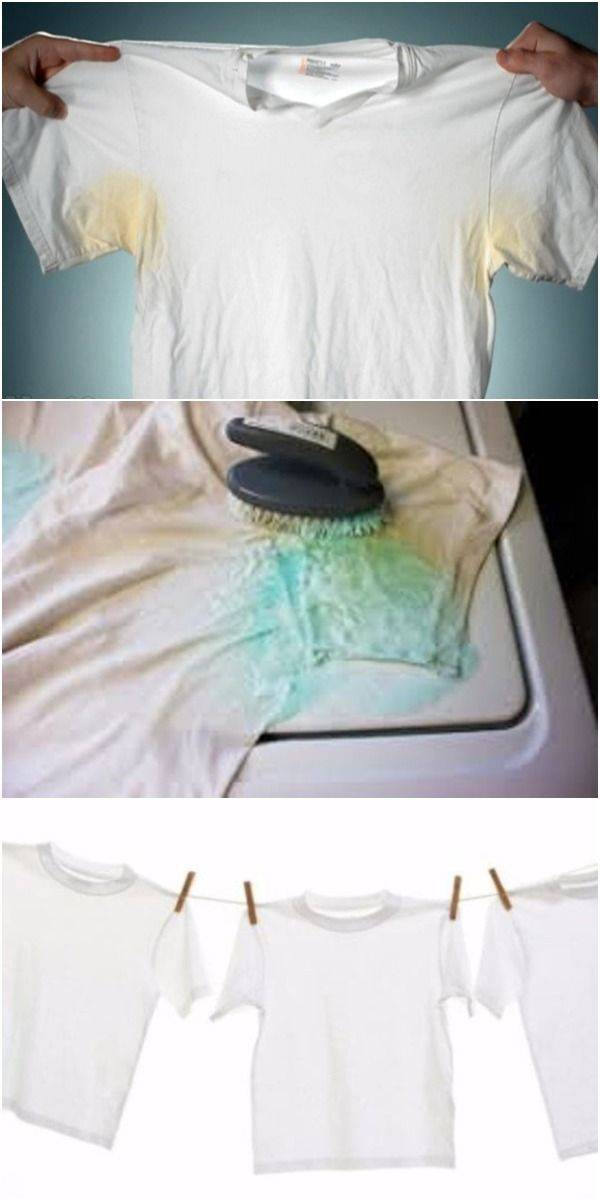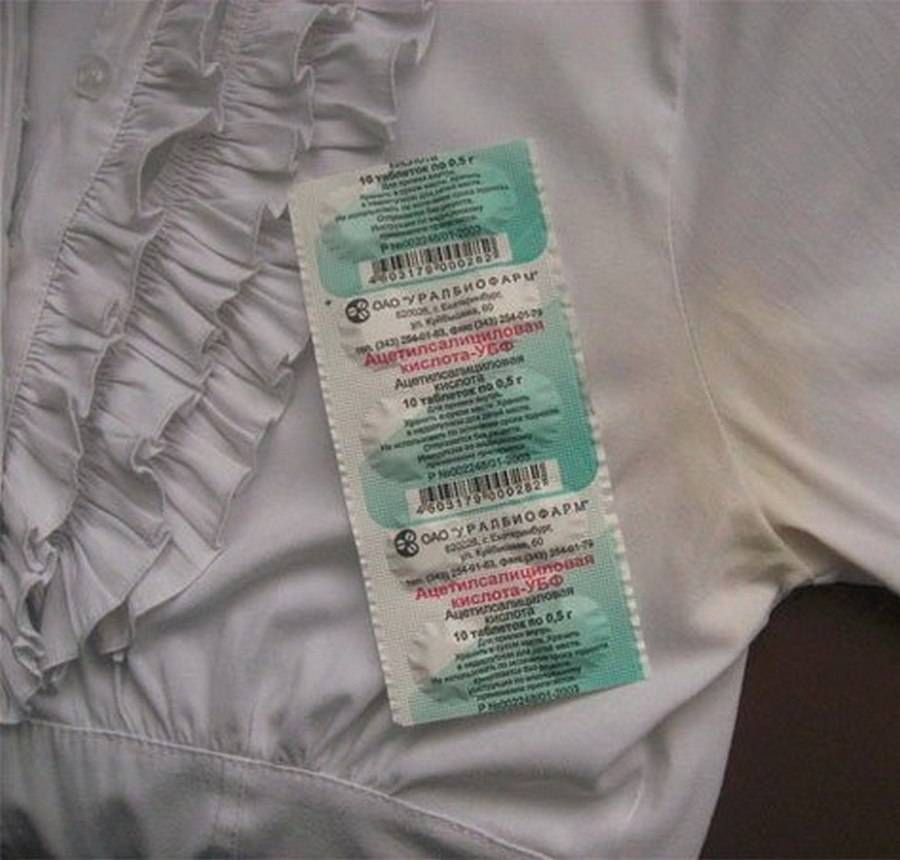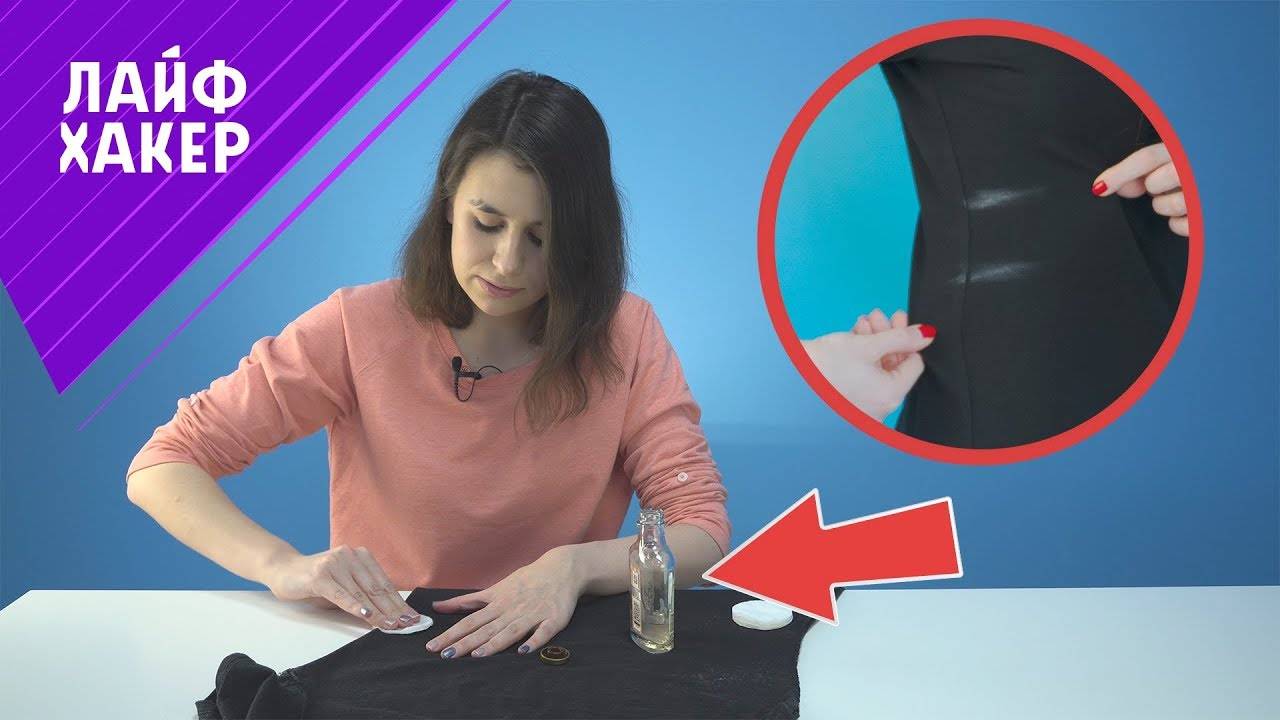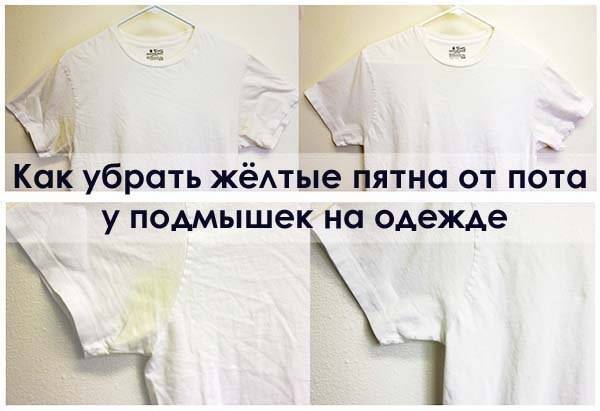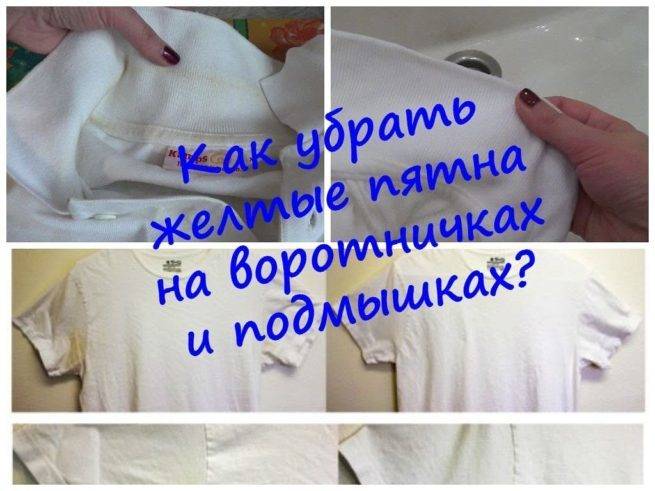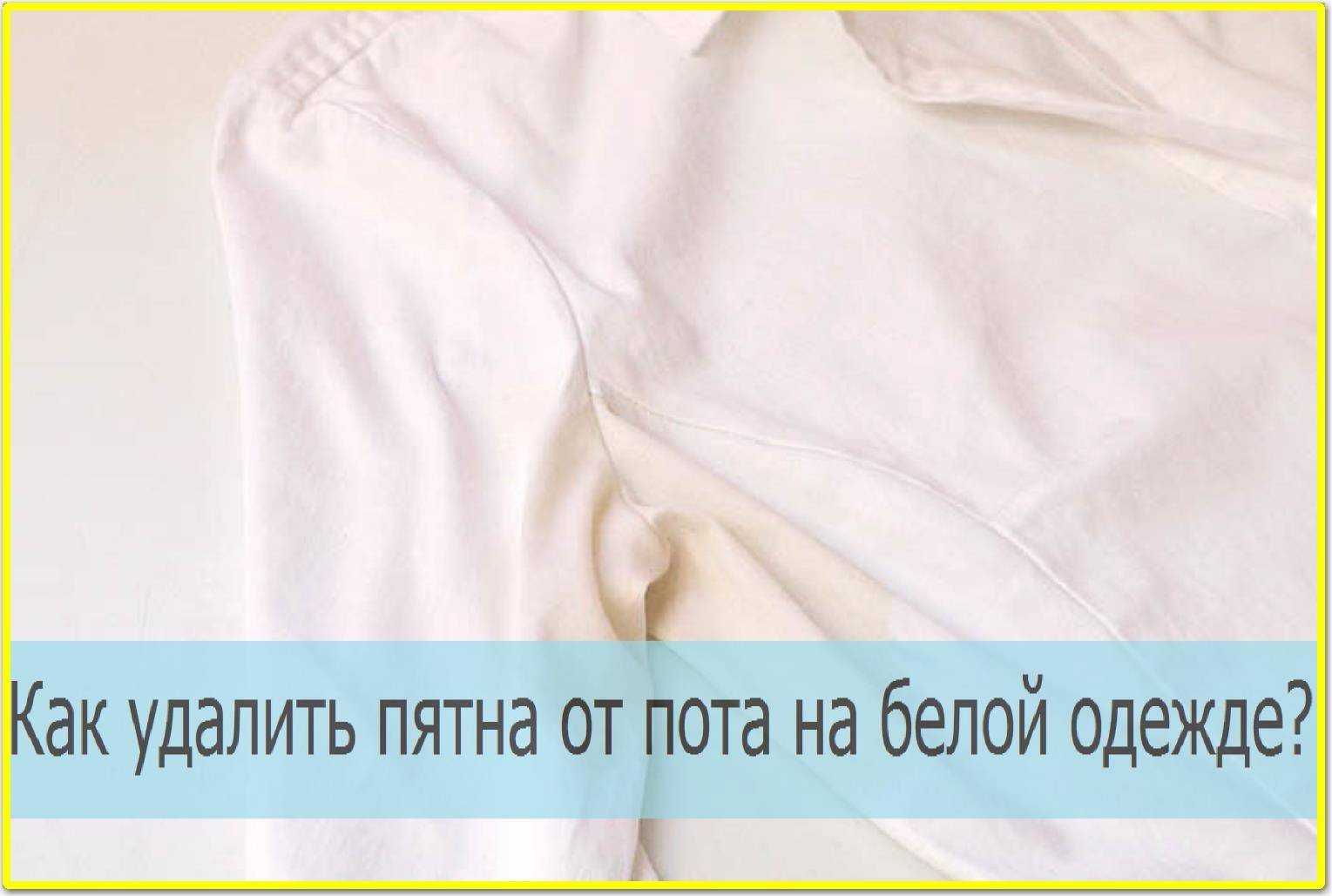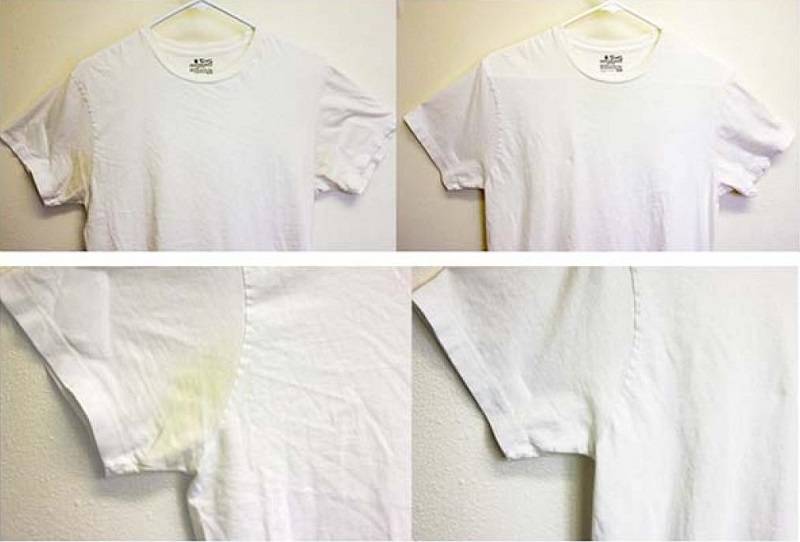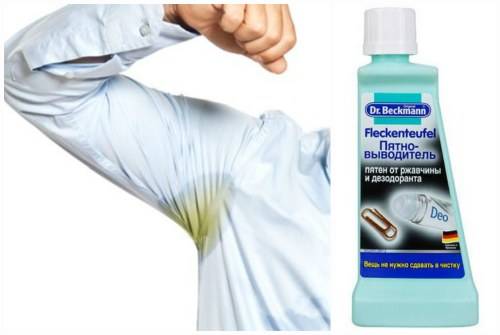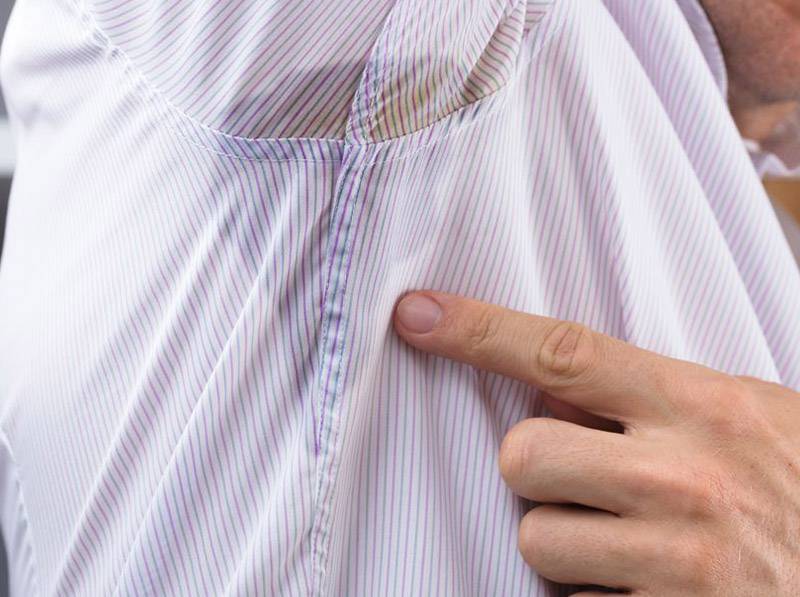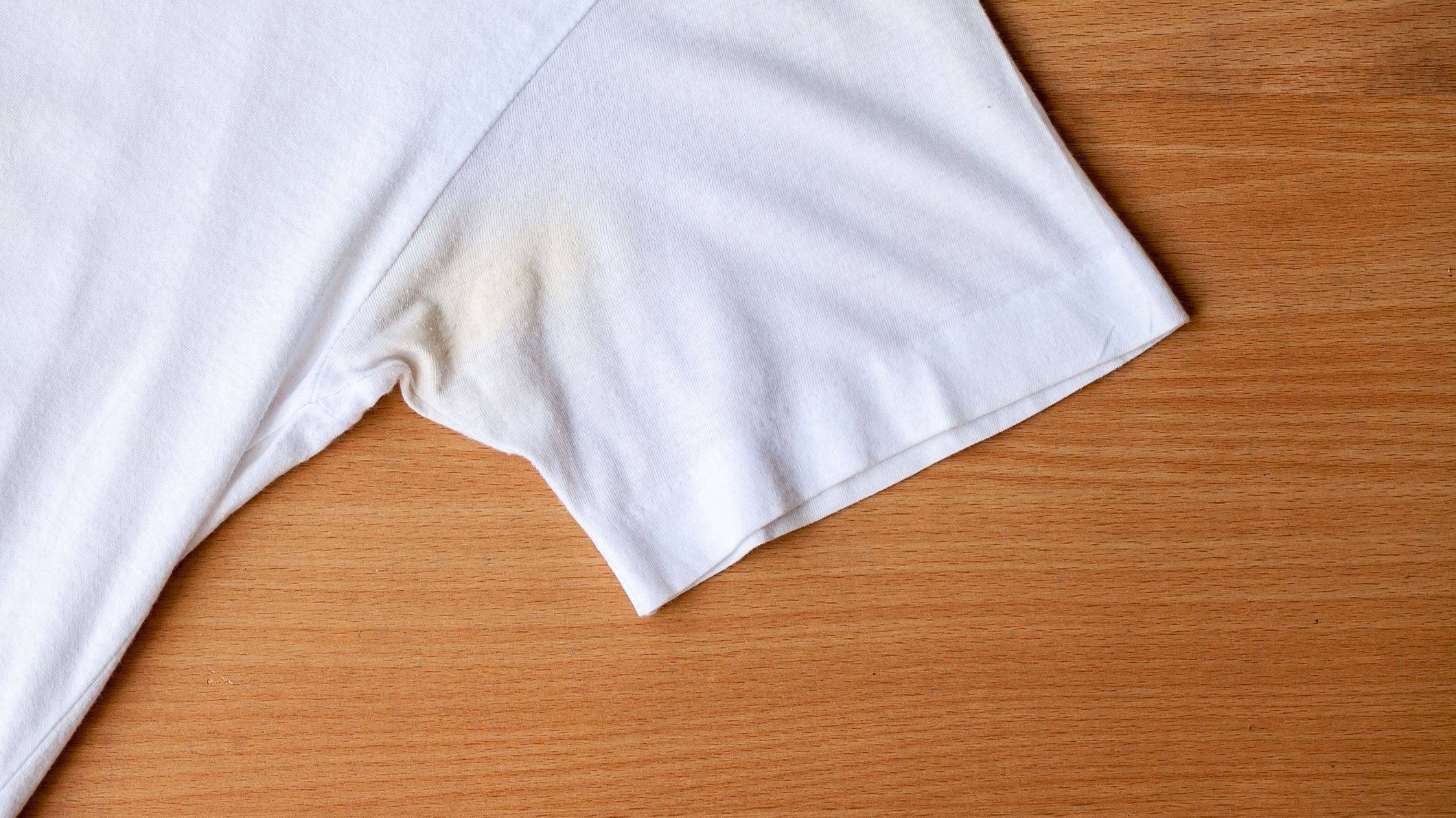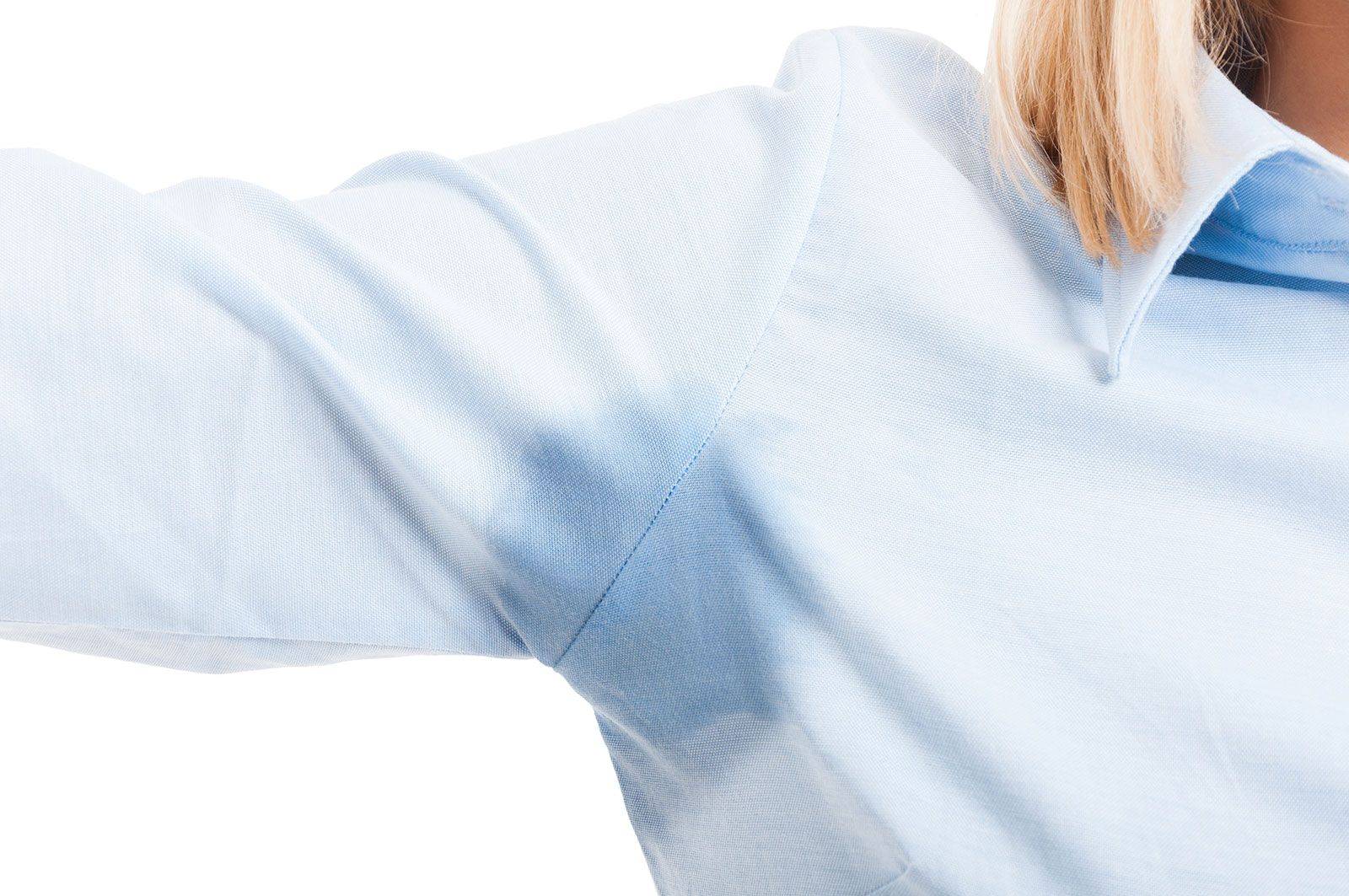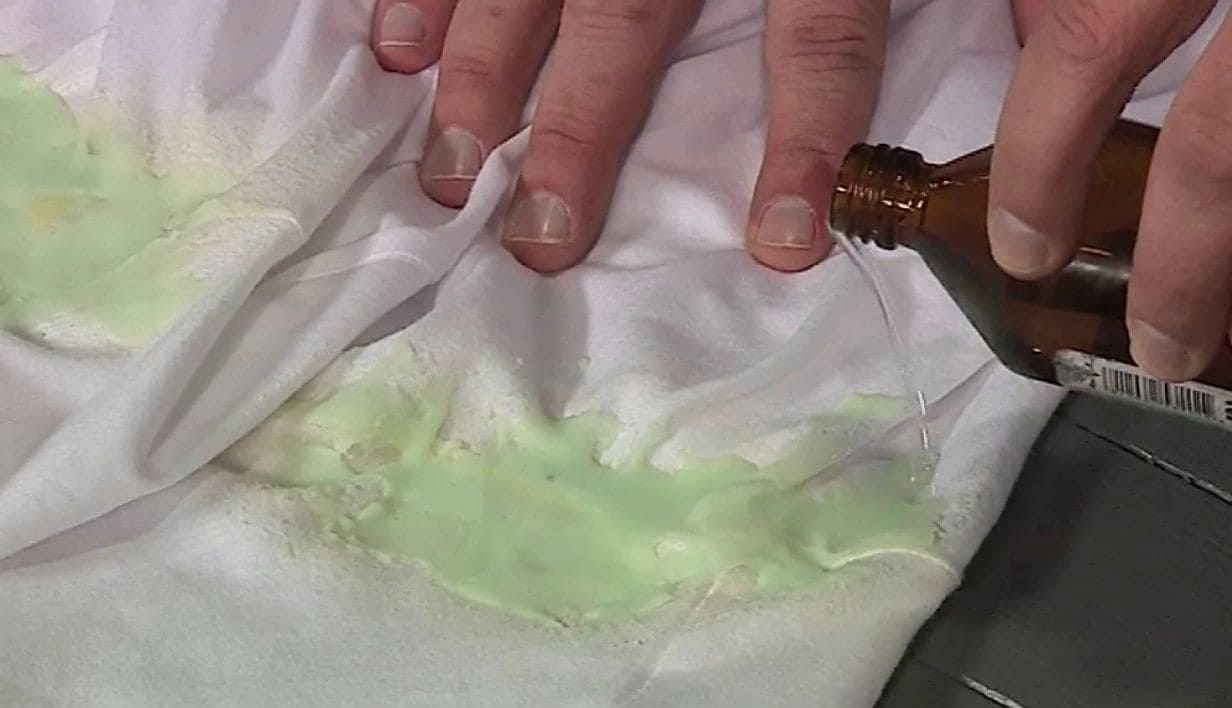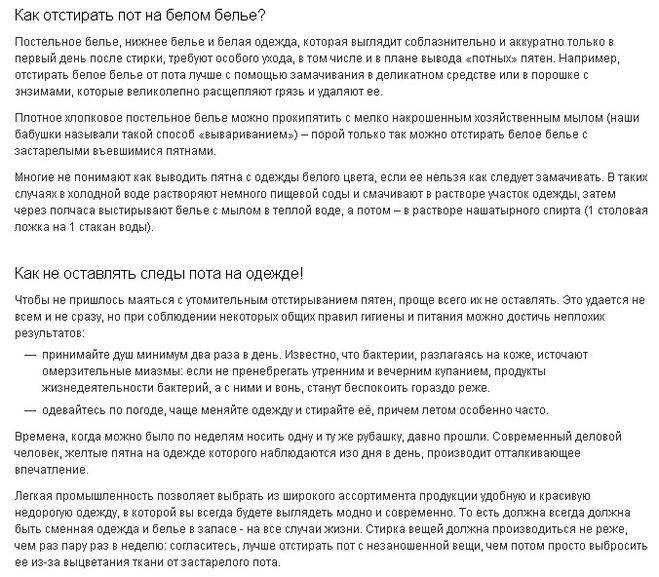What to do if sweat stains are ingrained and won't wash off?
Despite the fact that the proposed options are effective, in some cases it is necessary to wash the stains under the armpits repeatedly. What to use to remove particularly stubborn dirt, aggressive solvents should be taken:
- Apply vinegar diluted by a third to the treatment area for 2 minutes, then wash;
- treat all problem areas with vodka without additives, rinse after 15-20 minutes;
- for 1 tbsp. l. citric acid or fresh lemon juice, take no more than 0.5 tbsp. warm water, pour the composition onto the sweat stain, wait 15 minutes, wash.
The process of sweating helps a person get rid of salts, harmful substances and excess moisture.
TV commercials show how deodorant can reduce the amount of discharge and prevent your clothes from getting wet. In practice, these products block unpleasant odors, but do not get rid of wet armpits.
The sweat from the armpit eats deep into clothing. It is difficult to wash it off; it mixes with bacteria and fat present on the surface of the skin. A chemical compound is formed - 85% water and 15% fat and protein secretions. This cocktail makes the process of removing stains difficult and time consuming.
How to reduce fresh pollution
Garments with sweat stains should be washed immediately after they have been removed. It is not at all necessary to resort to store-bought "chemistry" - simple and affordable products can help, which, for sure, will be found in any home. Consider how to remove sweat stains using folk methods.
Method 1 - soapy
When it comes to fresh dirt, there is no better cleaner than ordinary laundry soap - it suits all types of fabrics, from cotton to finicky wool, can be used on both light and dark canvases without the risk of leaving marks and etching the paint.
The simplest method of using soap is to dilute the shavings in warm water and soak the damaged item for about an hour and a half. This action is applicable to wool products, but it is recommended to act in a slightly different way with other types of fabrics:
- Rub the yellow markings liberally with a soap bar;
- after half an hour, wash the treated areas by hand;
- wipe the traces of sweat with a sponge dipped in a solution of oxalic acid (1 teaspoon in a glass of clean water);
- after another ten minutes, rinse thoroughly.
Method 2 - soda
How to remove yellow spots from sweat with baking soda. This food product works as well as soap and can be used on almost all types of fabrics. To remove unpleasant stains, you need to mix the powder with a small amount of water until you get a gruel (about 4 tablespoons per 50 ml). Transfer the resulting paste to the stains and leave for an hour and a half. This is followed by a regular machine wash, it is better to dry the thing at room temperature.
Method 3 - saline
Table salt also works well with sweat stains - just dissolve it in water for one handful per liter and immerse the soiled wardrobe item in the resulting solution. After an hour, the fabric will be carefully washed and rinsed.
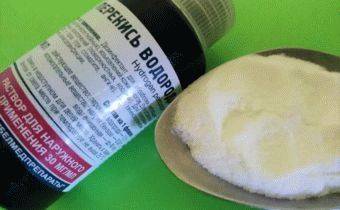
Method 4 - peroxide
Hydrogen peroxide, which is certainly found in every home medicine cabinet, is widely used in washing - for example, it perfectly removes coffee traces from clothes and towels. She can also remove yellow spots from sweat on white, and with a full guarantee of safety for the fabric.
Old stains are removed with a clean, undiluted antiseptic, but newly appeared stains can be successfully reduced with diluted ones: 1 table. spoon per liter of water. The liquid is applied locally in problem areas, after absorption, the thing is washed in a machine. Traditional soaking is also not prohibited: in this case, hydrogen peroxide is poured into a bowl of warm water, the clothes are immersed for half an hour, and then dried without washing with powder.
Method 5 - vinegar
Vinegar is good because it not only removes stains, but also completely neutralizes the smell of sweat. It is most convenient to spray it on dirt from a spray bottle, in the form of an aqueous solution, although it is quite possible to adapt it for machine washing: measure a quarter of a glass of product for every 10 liters of water.
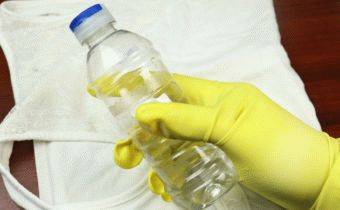
Attention! Experiments with vinegar are unacceptable when washing delicate fabrics, and especially silk products, but, on the contrary, it is ideal for cotton and linen. Vodka diluted with water can be considered a safe substitute.
If the stains are in no hurry to come off the fabric, you can try this procedure:
- Dissolve half a tablespoon of vinegar in 5 liters of water;
- soak stained clothing for 30 minutes;
- after the expiration of the period, rub the contamination with a soda solution: 4 table. tablespoons of powder in a glass of heated water;
- leave the thing "to lie down" for another quarter of an hour, and then wash in the usual way (it is best to use laundry soap). Industrial stain removers should be resolutely abandoned - if the method did not work the first time, just repeat all the steps again.
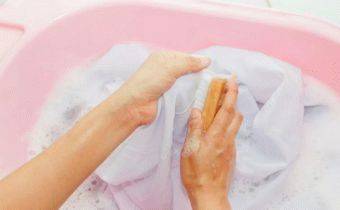
Video
To learn how to save yellow sweat from white items, watch the following video:
A young mother, wife and part-time freelancer. Being a lawyer by training, she is used to collecting and providing the most complete and reliable information. Constantly improving in the professional field and striving for personal growth and development.
Found a bug? Select the text with the mouse and click:
The dishwasher is not only good for dishes and cups. It can be loaded with plastic toys, glass shades of lamps and even dirty vegetables, such as potatoes, but only without the use of detergents.
The habit of using the washing machine "sparingly" can lead to an unpleasant odor in it. Washing at temperatures below 60 ℃ and short rinses allow fungi and bacteria from dirty clothes to remain on the inner surfaces and actively multiply.
There are special traps to fight moths. The pheromones of females are added to the sticky layer with which they are covered, attracting males. Sticking to the trap, they drop out of the reproduction process, which leads to a decrease in the moth population.
Threads made of gold and silver, which in the old days were used to embroider clothes, are called gimp. To obtain them, the metal wire was pulled for a long time with pliers to the state of the necessary fineness. Hence the expression "pull (breed) gimmick" - "engage in long monotonous work" or "delay the execution of the case."
Before removing various stains from clothes, you need to find out how safe the selected solvent is for the fabric itself. It is applied in a small amount to an inconspicuous area of the thing from the wrong side for 5-10 minutes. If the material retains its structure and color, you can move on to stains.
Fresh lemon is not only suitable for tea: clean the dirt from the surface of the acrylic bathtub by rubbing with half a cut citrus, or quickly wash the microwave by placing a container with water and lemon slices in it for 8-10 minutes at maximum power. The softened dirt will simply be wiped off with a sponge.
Stretch ceilings made of PVC film are capable of withstanding from 70 to 120 liters of water per 1 m 2 of their area (depending on the size of the ceiling, the degree of its tension and the quality of the film). So you don't have to worry about leaks from the neighbors on top.
If the first signs of bearing in the form of untidy pellets appeared on your favorite things, you can get rid of them using a special machine - a shaver. It quickly and efficiently shaves off clumped fabric fibers and makes things look worthy.
The easiest way to remove scale and carbon deposits from the soleplate is table salt. Sprinkle a thick layer of salt on the paper, heat the iron to maximum, and press the iron several times over the salt mat using light pressure.
Colored and dark things
Sweat stains are not as noticeable on dark and colored items as on whites. But still, such traces are visible and look like dark stains with a whitish outline from the salt contained in human sweat. It should be noted that for black and colored fabrics, you should not use bleaching agents, including: peroxide, citric acid, and soda. In addition to them, there are other, no less affordable means that can cope with such pollution.
Laundry soap
An excellent method, however, works mainly with fresh spots. The procedure is simple:
- Rub the soiled area on clothing thoroughly with soap.
- Leave the thing for an hour.
- After the allotted time, rinse the item and throw it into the washing machine.
Salt and ammonia
Suitable mainly for linen and cotton clothing. To remove stains from black clothes you will need:
- Dilute salt (1 tablespoon) and ammonia (1 teaspoon) in a glass of water.
- Fill the place of contamination with the resulting solution and leave for an hour.
- Wash a thing by hand or in a typewriter.
Salt and soap
- Prepare a soap solution in a basin, in which the item to be washed should be soaked for half an hour.
- Dissolve two tablespoons of salt in a glass of water.
- Apply the resulting solution to the dirt and leave the clothes like this for a couple of hours.
- Wash and rinse the item as usual.
Vinegar
- Table vinegar (two tablespoons) should be dissolved in six liters of water.
- Immerse the clothes to be washed in the resulting solution and let stand for about half an hour.
- Dilute ammonia with water in a 1: 2 ratio
- Treat contaminated areas with a cotton pad or a white cloth soaked in the resulting solution.
- Wash and rinse clothes.
White spirit and ammonia
Dilute white spirit and ammonia in a ratio of 2: 1, then pour the contamination with this solution without rubbing and leave in this position for a couple of hours. After the allotted period of time, rinse thoroughly and put the item in the washing machine.
Reasons for the appearance of stains on clothes under the arms
Sweating is an integral part of the normal functioning of our body, not always comfortable in everyday life. Stress, overweight, changes in hormonal levels, increased thyroid function, banal heat on the street - all this can cause increased moisture release in the armpits.
In fact, the sweat of a healthy person is colorless and does not have a pronounced odor. Most of the stains on the fabric are from dried stains. Yellow spots on white clothes, and white on dark clothes are the result of mixing antiperspirant / deodorant with sweat gland secretions. There is another reason, but not so harmless - chromohydrosis, disruption of the work of sweat glands, as a result of which sweat acquires an unusual color, therefore, noticeably stains clothes.
How to remove deodorant marks on different fabrics?
First of all, you should try to wash things in the washing machine using different programs. Only if this did not bring the expected result, you need to move on to all kinds of "improvised" methods. It is worth considering that they do not always give a guaranteed result, since the conditions for the formation of spots are constantly changing. Therefore, the above methods are rather advisory in nature.
Stains on colored fabric
Due to the fact that such fabrics contain dyes, they react extremely sharply to products with active and aggressive components. Therefore, they should be used as a last resort. Typically, for cleaning colored fabrics are used:
Table salt
Moisten the stain well with saline before removing deodorant from clothing under your armpits.
 The effect of washing will increase if you first apply a saline solution to the stain.
The effect of washing will increase if you first apply a saline solution to the stain.
Dishwashing liquid
The affected area is treated directly with gel or solution and kept for half an hour. Then a regular wash.
 A regular dishwashing detergent can help remove the stain.
A regular dishwashing detergent can help remove the stain.
Egg yolk and denatured alcohol
Both components are mixed in equal parts, and the resulting mixture is applied to the stain. Soak enough for about half an hour, then rinse with water and wash.
 The egg yolk is mixed with alcohol and applied to the fabric.
The egg yolk is mixed with alcohol and applied to the fabric.
Stains on white fabric
White tissue is more "relaxed" about various active substances, so they can be used relatively fearlessly. These include vinegar, citric acid, hydrogen peroxide, and alcohol and alcohol-containing liquids. In addition, regular laundry soap can be quite effective.
 Stains on white fabric can be removed with active ingredients.
Stains on white fabric can be removed with active ingredients.
How to remove underarm stains on black fabric?
The same cool brine or soap is still considered a good remedy. In some cases, aspirin shows sufficient effectiveness. To do this, a couple of tablets must be crushed to a powdery state and dissolved in a glass of water. Dampen the stain and rub with a brush or rough cloth. Wash as usual.
 Stains are removed from black fabric in slightly different ways.
Stains are removed from black fabric in slightly different ways.
You can also use ammonia: soak laundry in a solution of ammonia (20 ml per liter of water) and wash by hand.
 You can soak the item in a solution of ammonia.
You can soak the item in a solution of ammonia.
Deodorant marks on cotton fabric
These garments are best treated with saline or laundry soap. Alcohol or vinegar should only be used if the fabric is thick.
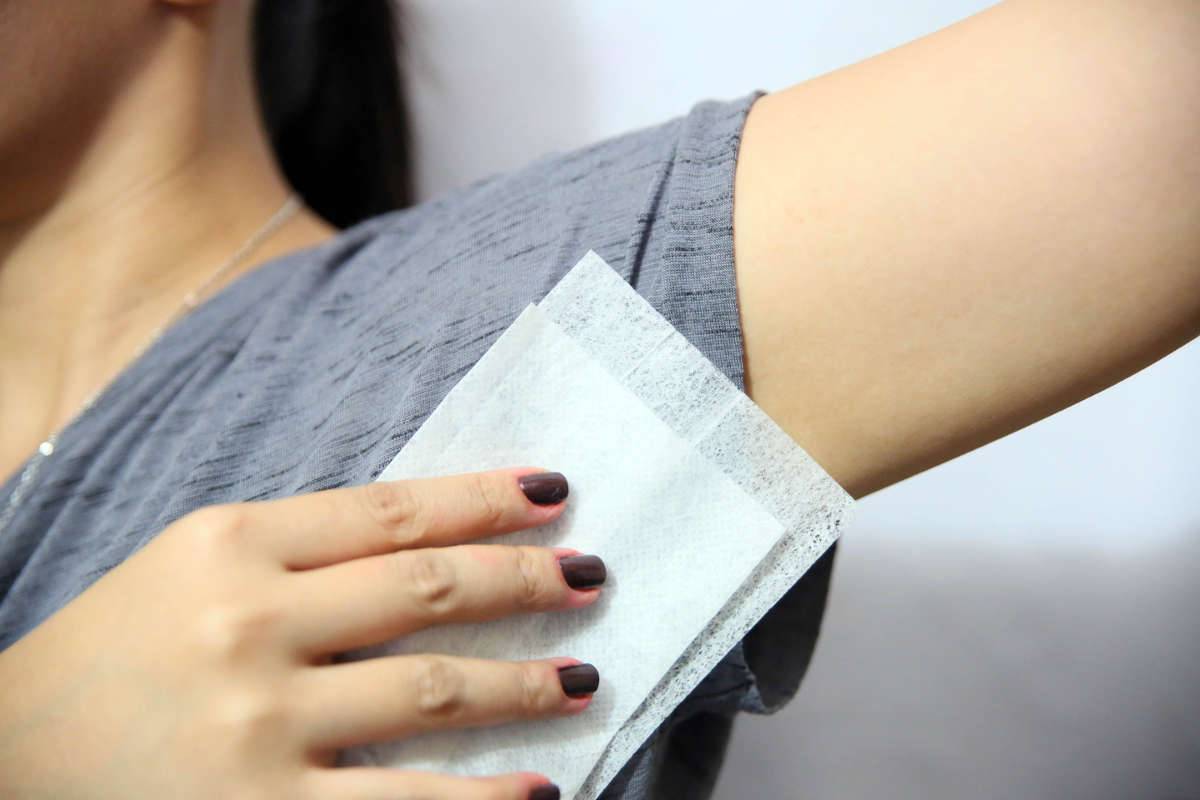 Cotton fabric is processed more carefully.
Cotton fabric is processed more carefully.
How to remove deodorant marks on woolen and linen fabrics?
This is where salt, soap, or baking soda comes in handy. A weak alcohol solution: 1 ml can give a good effect. in a glass of water. In severe cases, sodium thiosulfate sometimes helps: soak the laundry in water and add 10 grams. drug. Leave on for 20 minutes, then rinse and wash.
Stains are removed from linen clothes with alcohol.
Deodorant on fine knitwear
Delicate fabrics should not be cleaned with any aggressive substance. Therefore, it is better to use special, industrial means here, and you need to wash it by hand!
 Thin jersey must be hand washed.
Thin jersey must be hand washed.
As a rule, ammonia is used for this.
Sweat marks on rayon fabric
You can remove stains with a mild saline solution, vinegar, or glycerin. In the latter case, you need to warm a small amount of it in a water bath and treat the stain. After 15 minutes, the fabric should be rinsed in warm water and washed.
 Artificial silk requires very careful handling.
Artificial silk requires very careful handling.
How to remove sweat on clothes
First you need to understand the nature of this very unpleasant phenomenon. These spots are formed as a result of the work of the human body, which by sweating gets rid of not only moisture, but also excess fats and salts, which penetrate tightly into the fibers of clothing, and remain there after drying.
Information. Also, deodorants leave their contribution, the particles of which are designed to remove an unpleasant odor. However, their surplus, along with fats and salts, "move" to live on the tissue.
Wash dark on shirts
Despite the fact that it is very difficult to remove underarm stains on clothes, and especially on shirts, there are a lot of effective options and folk methods for this enterprise.
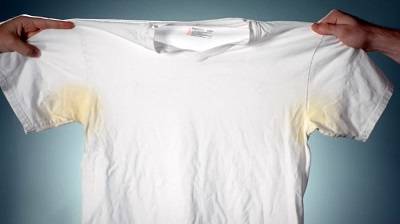 How to remove underarm dark spots from sweat
How to remove underarm dark spots from sweat
If the stains are so fresh that they are even wet, then it is reasonable to rub the underarm area of the T-shirt with laundry soap.
Then put wet soda gruel on the soap, leave it for an hour and a half, then wash in the usual way.
How to remove wet sweat stains on shirts
- For this method, we need a kettle, a tablespoon of soda and a tablespoon of salt;
- We heat 250 ml of water;
- Add salt and soda to it, stir;
- Pour the resulting elixir of purity onto the stains, leave for 2-3 hours, wash in the usual way.
A way to remove yellow spots under the armpits on clothes
In fact, a slightly modified second method, where liquid soap is used instead of water, of course, in a smaller amount.
Remove whites on black
Method number 1
A very simple, but effective way:
- Take dish liquid;
- Dilute it with water and washing powder;
- Leave the damaged items soaked overnight;
- In the morning, rinse the clothes to remove excess soap and wash them in the usual way.
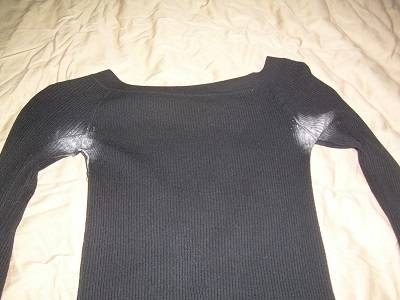 Method number 2
Method number 2
This method of removing stains from the armpit is widely known in the vastness of the post-Soviet space.
For it you will need aspirin (acetyl-salicylic acid), water and the damaged item itself.
An aspirin tablet must be moistened with water, brought to a mushy state and rubbed onto the soiled area.
After thirty minutes, wash the thing in the most ordinary and usual way for her.
Method number 3
In the case when there is no aspirin in the house, you can use a wonderful method based on peroxide, which is more likely to be in every home. We just take a bottle of peroxide and pour it onto the contaminated area. After twenty to thirty minutes, we wash the thing.
Method number 4
Suitable only for dark and colored clothes! This method can be dangerous for white items, as it can leave behind yellow spots. In the evening we moisten the stain with vinegar, and in the morning we wash the thing in the mode in which you always wash your clothes.
Method number 5
This method will help you remove white deodorant stains from black clothing. You will need a little vodka, which should be poured in a small amount over the stained area. After half an hour - an hour, wash the thing in its usual mode. If the stain does not want to give up, repeat the procedure after the item has dried.
Very often, these stains are formed not only due to the chemical elements released by our body, but also due to the chemical composition of our favorite deodorants.
Important! If you want to minimize the likelihood of recurrence of the appearance of such stains in the future, give up deodorants that contain aluminum.
It is easier to remove fresh stains than those that are "a hundred years old at lunchtime."
It is more difficult to deal with old stains, and using strong means, you risk ruining the thing.
Therefore, every time you come home, you need to pay attention to the external state of things, its pollution. Attention! There are methods for removing such stains using acetone, but in no case should acetone be used on colored fabrics! All acetone-containing methods are suitable only for white tissues.
Attention! There are methods for removing such stains using acetone, but in no case should acetone be used on colored fabrics! All acetone-containing methods are suitable only for white tissues.
Folk methods
There are a large number of different stain removers on the modern market. They are not all equally effective. As part of any stain remover, well-known folk methods are used as a basis. To remove dirt from color and black, you can use one of them directly.
Salt
To remove deodorant stains from clothing, the stains must be moistened with warm water. Then apply a generous amount of table salt. The processed item should be left in this form for 5-10 hours. In this case, it is necessary to avoid drying out and periodically wet the treated areas.
After the required amount of time has elapsed, until the stains go away, the clothes must be rinsed and then washed in the usual way.
Vinegar
9% table vinegar is widely used in everyday life to combat stains of various origins. In this case, it is also effective. In its pure form, it is abundantly applied to the places of contamination with a cotton pad. Then the thing should be left for 1, 5-2 hours. Then wash in the washing machine.
Lemon juice
Freshly squeezed lemon juice should be applied to contaminated areas. It should saturate the fabric completely. Therefore, you will need to take at least 1 tbsp. l. The processed product is left for 40-60 minutes. Then it should be thoroughly rinsed and washed.
Unplugging the washing machine?
Oh yes no
Liquid dishwashing detergent
Copes with most tough stains. In this case, a gel containing glycerin is suitable. Apply generously to antiperspirant stains and let sit for 30 minutes. Then the thing should be soaked completely and left for another 1 hour. Then wash.
Alcohol or vodka
You can get rid of white spots using one of these remedies. In its pure form, vodka is applied to contaminated places for 30-40 minutes. Then the item should be washed using detergent powder.
Important! Vodka is applied to dirt in its pure form. Alcohol should be pre-diluted with water 1: 1
Ammonia
Mix in equal proportions with water. With this liquid, it is necessary to abundantly process the fabric in contaminated areas. After standing for 30-40 minutes, the thing should be washed in the usual way.
Hydrogen peroxide with baking soda and dishwashing liquid
The blend of these products can successfully deal with most difficult dirt that is difficult to remove. Soda and dishwashing detergent are taken in equal proportions and mixed. Peroxide 1: 4 should be added to the resulting paste (4 parts of a mixture of soda and gel, 1 part of peroxide).
The composition must be applied to the stains and left to act for 2 hours. Then the item should be washed.
Nylon stocking or sock
To get rid of white traces of antiperspirant on black clothes, the place of contamination must be rubbed with a nylon stocking until the desired result is achieved. Then wash the product in the usual way.
A mixture of borax, kefir and vinegar
You can get rid of traces of deodorant using this composition. All components are taken in equal parts. The resulting homogeneous mass should be rubbed onto the item and left to act for 40-50 minutes.
Aspirin
Tablets in the required amount should be crushed into powder and sprinkled with them previously moistened with warm water contaminated areas. Leave to act for 1 hour.
Denatured alcohol or white spirit
Denatured alcohol successfully removes underarm stains on colored and black clothes. They should soak contaminated areas and leave for 60 minutes to act. Then the thing must be washed using washing powder.
Hyposulfite
Dilute with water 1: 1 and soak a thing in the resulting solution for 30-60 minutes, depending on the area and resistance of contamination. After that, the product should be thoroughly rinsed.
Ways to remove sweat marks from things
In any case, it is important to know how to get rid of yellow spots when they appear. There are many ways to help with this.
1Using laundry soap. It is a great helper in the fight against sweat stains on white. To do this, you need to wet the thing and rub the contaminated areas with soap. Leave the clothes in this form for 10-15 minutes, and then rub the soapy areas with your hands.Despite the untidy appearance of laundry soap and its unpleasant smell, after washing, there will be no trace of stains.
2How To Get Rid Of Yellow Spots When Using Baking Soda? First you need to make a soda paste. We mix a small amount of soda with water until a slurry is formed. Now we apply the prepared product to the wet thing and rub it a little with a brush. After that, we wash the thing in the usual way. This method is great for removing stains from white clothing.
3Hydrogen peroxide. This method will remove the yellow sweat stains that are out of date. You need to make a special pasta. To do this, take 2 tablespoons of baking soda, 1 spoon of gel and 30 ml of hydrogen peroxide. We mix everything thoroughly and apply to an outdated spot, leave it for 10 minutes, and then brush it. If you did not succeed in removing yellowness from things at once, then you can repeat the cleaning procedure again
It is important to remember: after washing, it is advisable to dry the thing in the shade, because if the fabric is unnatural, then yellow stains will remain on it.
4 Aspirin is suitable for removing yellow streaks from both black and white clothing. How to remove the yellow trail with aspirin? You need to grind the tablet into powder and add a little water to get a thick mixture
Now it can be applied to the problem area, having previously moistened it with warm water. To achieve a good result, you need to leave the mixture on your clothes for several hours, then wash the item with powder and rinse well.
5Soda and salt will help get rid of yellow spots. It is better to take fine salt. An equal amount of baking soda and salt should be mixed with liquid soap, and then applied to the formed yellow areas under the armpits. This method will definitely help get rid of the unwanted problem.
6 Remove yellowness with ammonia. Mix the ammonia with a small amount of salt and apply it to the surface of the fabric. We give time to act so that the dirt dissolves, after which we wash the thing in the usual way.
7Vinegar or citric acid. We breed 1 tsp. vinegar or citric acid with a glass of water and rub the armpits well with this solution. In order for the product to have time to dissolve the remains of sweat on the fabric, it is necessary to give it 2-3 hours. This method is suitable for colored and white clothes, so you can safely use it. It is important to remember that if vinegar is used, then the washed item must be rinsed well several times in order to remove the pungent odor.
8How to remove yellowness with vodka? It is necessary to rub the resulting stain with vodka, and then wash in the usual way. Do not be alarmed if at first the yellowness becomes more saturated - after washing it will be completely removed. This method is suitable for small fresh stains, as vodka cannot remove old stains.
9 Oxygen-free chlorine-free bleaches. Specially formulated stain removers can effectively remove yellow spots under the armpits. It is recommended to carefully study the instructions before use, so as not to spoil the fabric.
10How to remove stains by boiling. It is worth knowing that it is only suitable for cotton fabrics. This method is great for removing old stains that cannot be removed with other methods. For digestion you will need: finely grated laundry soap, water and an aluminum container for boiling. Pour the soap into the water and bring it to a boil, put the thing with the stain there and boil it for several hours, depending on the degree of pollution.
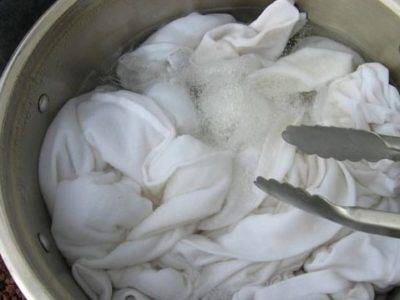
We recommend that you familiarize yourself
After boiling, it is recommended to rinse the items thoroughly with the addition of fabric softener. It will help restore tissue after prolonged digestion and give it freshness.
How to remove stubborn sweat marks
Removing stubborn yellow spots can be tricky, but using home remedies wisely can help save your favorite items.
Soda can remove traces of sweat, antiperspirant or deodorant. Safe for white items made from various materials. At the same time, it not only removes impurities, but also eliminates the smell of sweat, disinfects.
To prepare a soda solution in 125 ml of water, dissolve 4 tbsp. l. soda. With the resulting product, treat the place of contamination and leave for 2 hours. After soaking, wash the product with powder and rinse well in cool running water.
Salt will help to save white clothes made of silk, linen or cotton. Dilute sodium chloride with a little water to make a gruel. Apply the product to the stain and leave it on overnight. Wash your clothes according to the recommendations for the type of fabric.
Aspirin can help remove stubborn sweat stains on white items:
- Grind 4 tablets of acetylsalicylic acid to a powder.
- Add some water to the aspirin. As a result of combining the two components, a gruel should be obtained.
- Apply the product to the stain and rub in a little, avoiding strong mechanical stress.
- Leave the garment for 3 hours and then wash or rinse the garment in cool water.
An aspirin solution will help remove traces of sweat from delicate fabrics. Dissolve two tablets of acid in 125 ml of water. Treat the dirt with the resulting product and leave for half an hour.
To remove sweat stains, you can use Persol bleach. When working with it, observe safety measures: wear gloves and avoid contact with the mucous membranes of the oral cavity and eyes.
How to remove yellow underarm spots on white with bleach:
- Dissolve a teaspoon of the product in a glass of water.
- Use an old toothbrush to rub the bleach into the stain without applying too much pressure.
- Leave the treated garment for an hour and a half, then wash and dry.
"Persol" is not suitable for clothes made of delicate materials.
Digestion will help remove yellowness from cotton products. Prepare a large container, fill it with water and add some grated laundry soap. Alternatively, you can use chlorine-free bleach. Place the clothes in a saucepan and set them on fire for 3 hours. At the end of the procedure, rinse the products in clean cool water using a conditioner.
Preventive measures and videos
Stubborn antiperspirant and deodorant stains can be a hassle. They are difficult to remove and much easier to prevent if preventive recommendations are followed. Correct use of deodorants helps to avoid problems. More details:
- It is necessary to give preference to quality products. Despite the fact that their cost can be several times higher, they are much more economical to use.
- Do not overuse antiperspirant. A thin, moderate coat is enough to protect yourself from odors and sweat marks all day long.
When using sprays, they should be sprayed from a distance of at least 20 cm.
Before applying deodorant, the skin must be completely dry and clean.
It is important.
Gels and sticks dry for about 10 minutes, and aerosols for about 5 minutes You can put on clothes only after the deodorant has completely dried.
White stains from deodorants and antiperspirants on colored and black clothes are difficult stains. Molecules of the products penetrate deeply into the fibers of fabrics and have water-repellent properties. That is why they are so hard to get rid of. You can remove traces of deodorant using any of the described means.
Useful Tips
Before looking for tools in your arsenal to combat sweat stains, let's figure out what exactly you shouldn't wash such problematic stains so as not to completely ruin the thing. Well, some useful recommendations from experts will not be superfluous:
- Never use chlorine bleach on colored or white fabrics.The fact is that the chlorine in its composition reacts with the proteins present in the sweat. This can darken the fibers of the fabric and make the stain even more visible.
- Do not wash these items in hot water. It can only contribute to the fixation of pollution. Sweat marks are best washed off at a temperature not exceeding 30 degrees.
- It is also recommended to dry the washed products in the shade, and not in the open sun or on a radiator.
- Silk products do not tolerate treatment with acetic acid and acetone, synthetics do not like gasoline and all its derivatives, cotton fabrics should not be treated with acids, and wool should not be treated with alkaline solutions.
- Acetone can discolor fabrics, so you shouldn't use it to remove sweat on colored clothing.
- After using the hydrogen peroxide, rinse the treated clothing several times.
- Before using any product, be sure to test it on a small, inconspicuous area of clothing, preferably from the wrong side. If the fabric is discolored or deformed, then it is better to choose another product.
- It is always easier to remove fresh marks than old ones, so treat dirt as soon as it appears, so you have a better chance of getting rid of them 100%.
- Sweat stains appear not only from perspiration, but also from the use of the deodorants themselves. It is advisable to wash the problem areas with laundry soap every time after using an antiperspirant. In this case, the likelihood of staining will be much less.

